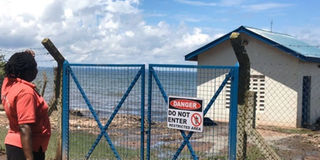Kalangala residents up in arms after water supply is cut off

A woman pictured on June 24 standing outside a contaminated water source at Mutambala landing site, Mugoye Sub County, Kalangala District. The water source was serves five villages. PHOTO BY SYVSTER SSEMUGENYI
What you need to know:
- A safe water project that government rolled out on selected islands over a year ago has remained nonfunctional.
Residents in five villages in Mugoye Sub County, Kalangala District have complained over industrial waste that contaminated a key water source in the area.
The affected residents are in the villages of Beta, Mutambala, Mugoye Ssemasiga, Senero and Busanga.
Residents say the incident happened sometime in May when there were heavy rains, and waste water overflowed from the factory and flowed along the road to the landing site, with water flowing into some houses along the road. The waste water also reached the water pump house and water supply was disconnected for some weeks.
The oil palm factory is run by Oil Palm Uganda Ltd (OPUL), a subsidiary of Bidco Uganda, which manages oil palm plantations on Bugala Island in Kalangala District.
Mr Musa Katongole, a resident of Beta Village, said their lives are at risk since they can no longer access safe and clean water.
“Access to clean water is a big challenge now. We have resorted to drawing water directly from the lake which exposes us to water borne diseases like cholera and dysentery,” Mr Musa Katongole told this journalist.
Currently, Mr Katongole said residents who fear using water from the lake trek about 4 kilometres to fetch clean tap water which costs between Shs500 and Shs 1,000 per 20- litre jerrycan.
Mr Sulait Kafeero, the chairperson Mutambala landing site, said apart from the contaminated water source, the effluents were also affecting them, however he added, that the management was providing some help.
“We recently engaged the management of OPUL on the matter and they gave some food items to the affected families,” he said.
According to Mr Joseph Mulindwa, the public relations officer Kalangala Infrastructure Services Ltd (KIS), there have been ongoing negotiations between KIS and OPUL to fix the problem.
“It is true we have not supplied water for close to two months because our pump got damaged and the water source is contaminated but negotiations are underway to see how we can jointly solve the problem,” he said.
KIS say that the water supply was disconnected because of high level of faecal contamination of the lake water at the pump station. While the wastage from the factory was mostly palm oil processing waste, their tests of the water showed high level of faecal material; the area near the pump has only one pit latrine and residents mostly use the bush.
Mr Richard Ssentongo, the client liaison officer at OPUL said the recent heavy rains caused the over flow of the company’s waste stabilisation ponds.
“We did not intend to release the waste into the water source; it was beyond our own control but we are handling the matter to save the situation,” Mr Ssentongo said.
The management of OPUL also said tractors were immediately dispatched to divert the flow when the incident happened, into the oil palm plantation away from the residents’ homes.
The Lake Victoria basin has received the heaviest rainfall in decades this year with the lake’s level rising to the highest point ever since 1964. Hotels and all developments along the shoreline have been grossly affected.
Kalangala District has 84 islands widely scattered on Lake Victoria. But district officials say it is only Buggala Main Island that has a wide safe water coverage of at least 70 per cent.
A safe water project that government rolled out on selected islands over a year ago has remained non-functional.
Commissioned in March 2019, the Shs270m Solar Water pump under the rural water project that was established by Kalangala District Local Government has failed to serve the intended purpose. The pump can only serve a distance of 1km yet the safe water coverage target extends to a distance of 4km, covering a school and communities on Bufumira Island.
The 2014 National Housing and Population Census estimates Kalangala population at 54,293. The households with access to piped water were estimated at 3,810 (19.3 per cent) of the total population of Kalangala District.
Clarification: This article was edited on July 17th to reflect the right context of the incident and views from all affected in the story.




